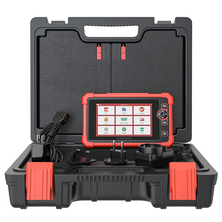
When Oil temperature of the engine is low? How to handle it?
The low oil temperature of a car engine refers to the situation when the temperature of the engine oil is below the recommended operating level.
Recommended 2023 top car diagnostic tool:Autel IM608II,Launch pro5,Launch IMMO elite,Launch PADVII,Launch crp919X
The low oil temperature of the engine can have the following impacts:
- Reduced engine performance: Low oil temperature can lead to decreased engine performance, including reduced power output and slower acceleration.
- Incomplete fuel combustion: Low oil temperature can result in incomplete fuel combustion, leading to increased emissions and environmental pollution risks.
- Increased wear and tear: Running the engine at low oil temperature can accelerate wear and tear on engine components, potentially impacting the engine's longevity and reliability.
- Decreased fuel efficiency: Low oil temperature can contribute to decreased fuel efficiency as the fuel may not burn efficiently, leading to higher fuel consumption.
- Potential damage during cold starts: Starting the engine when the oil temperature is too low can cause increased friction and wear on engine parts, potentially leading to damage over time.
- Delayed warm-up period: Operating the engine at low oil temperature requires a longer warm-up period, which can result in extended idling time and increased fuel consumption.
The low oil temperature of the engine can be caused by various factors, including:
- Cold weather conditions: In cold climates, the initial temperature of the engine is lower, requiring more time to reach the normal operating temperature.
- Extended periods of inactivity: When a vehicle remains parked or unused for a prolonged period, the engine's temperature decreases, necessitating a longer startup and warm-up process.
- Inefficient or faulty cooling system: A malfunctioning or inefficient cooling system can prevent the engine from reaching and maintaining the optimal operating temperature, resulting in lower oil temperature.
- Thermostat issues: A malfunctioning thermostat can prevent the engine from reaching the desired operating temperature, leading to lower oil temperature.
- Improper oil viscosity: Using oil with a lower viscosity than recommended by the manufacturer for specific temperature ranges can contribute to lower oil temperature.
- Oil cooler problems: Issues with the oil cooler, such as blockages or leaks, can hinder the proper flow and heat exchange, leading to lower oil temperature.
- Identifying and addressing the underlying causes of low oil temperature is crucial to ensure proper engine function, efficiency, and longevity. Regular maintenance and inspections can help prevent and resolve such issues.
To prevent and address the issue of low oil temperature in the engine, the following preventive measures and solutions can be implemented:
- Use an engine preheater: In cold conditions, using an engine preheater can help to warm up the engine before starting, reducing the decrease in oil temperature during startup.
- Extend the warm-up period: In low oil temperature conditions, allowing the engine to idle and warm up for an extended period can gradually increase the oil temperature to the normal operating range.
- Check the cooling system: Ensure that the cooling system is functioning properly, including checking the coolant level, radiator, and cooling fan, to avoid excessively low oil temperatures.
- Insulate the engine: Installing insulation blankets or engine block heaters can help retain heat within the engine, minimizing heat loss and maintaining higher oil temperatures.
- Use the recommended oil viscosity: Follow the manufacturer's recommendations for the appropriate oil viscosity based on the operating temperature range to ensure optimal oil temperature and lubrication.
- Replace a faulty thermostat: If a malfunctioning thermostat is causing the low oil temperature, replacing it with a new one can help regulate the engine's operating temperature effectively.
- Inspect and clean the oil cooler: Regularly inspect and clean the oil cooler to remove any blockages or leaks that may be affecting the oil flow and heat exchange, ensuring proper oil temperature regulation.
The low oil temperature of the engine can result in the following consequences and risks:
- Increased engine wear: Running the engine at low oil temperature can lead to increased wear and tear on engine components, such as the bearings, pistons, and cylinder walls, potentially reducing engine lifespan and reliability.
- Poor lubrication: Low oil temperature can impair the effectiveness of lubrication, leading to inadequate protection of moving parts and increased friction, which can further contribute to premature engine wear.
- Sludge formation: Insufficient oil temperature can cause the accumulation of sludge and deposits in the engine, hindering proper oil flow and potentially clogging oil passages, which can restrict lubrication and cooling.
- Increased fuel consumption: Low oil temperature can negatively impact fuel efficiency as the engine may require more fuel to compensate for the reduced performance and inefficient combustion caused by low oil temperature.
- Reduced power and performance: Inadequate oil temperature can result in decreased engine power output and compromised performance, leading to sluggish acceleration and reduced overall driving experience.
- Increased emissions: When the engine operates at low oil temperature, fuel combustion may not be optimal, resulting in increased emissions of pollutants, contributing to environmental pollution and failing emission tests.
To monitor and maintain the oil temperature of the engine, the following practices can be employed:
- Use an oil temperature gauge: Install an oil temperature gauge in the vehicle dashboard to monitor the oil temperature in real-time. This allows for timely detection of low oil temperature issues and facilitates appropriate action.
- Follow manufacturer recommendations: Adhere to the manufacturer's guidelines regarding the ideal oil temperature range for the specific engine model and operating conditions.
- Regularly check oil levels: Monitor the oil level in the engine using the dipstick or electronic oil level sensor. Ensure that the oil level is within the recommended range to promote optimal oil temperature.
- Check the oil cooler: Inspect the oil cooler regularly for any blockages, leaks, or damage. Clean or repair the oil cooler as necessary to maintain proper oil flow and heat exchange.
- Replace oil and oil filter: Regularly change the engine oil and oil filter as per the manufacturer's recommended intervals. Fresh oil with the right viscosity helps maintain proper oil temperature and lubrication.
- Warm up the engine: Allow the engine to warm up sufficiently before driving, especially in cold weather conditions. This helps raise the oil temperature to the desired operating range.
- Inspect the thermostat: Ensure the thermostat is functioning correctly. A faulty thermostat can cause the engine to run at lower temperatures. Replace it if necessary.
- Use synthetic oil: Consider using synthetic oil, especially in colder climates. Synthetic oil tends to flow more easily at low temperatures, helping to maintain optimal oil temperature.
Older Post
 Newer Post
Newer Post

Why Headlights lights lose brightness?

What happens when a NOx sensor shows deviations or errors?










